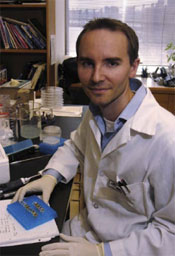Contents
- Cover Story
Forging a Path From Laboratory to Clinic
Critical Resources
Forging a Path From Laboratory to Clinic
Moving Research from the Laboratory Bench to Patients
Another challenge faced by clinical and translational researchers is that their work calls for a broad set of skills and expertise that is rarely found in a single laboratory or department. “In the long run, the consortium will make translational and clinical research more economical and efficient by providing access to important skills and technologies currently limited to defined disciplinary areas or specific labs,” explains Berglund.
Institutions belonging to the CTSA consortium are establishing centralized facilities for specialized technologies, such as combinatorial chemistry and molecular therapies, imaging and informatics, as well as repositories of patients’ samples. “These are institutional resources traditionally undersupported,” says Califf. “All researchers can use them and have access to them more readily and at a lower cost than if they had to seek them out on their own.”
In addition, CTSAs provide support for patient-oriented studies by providing access to patients and to trained medical personnel who can help researchers with medical evaluations, protocol design, review of clinical laboratory findings, and other competencies. This support is particularly critical to scientists in basic science departments, like Marc Flajolet at The Rockefeller University, who are not trained or do not have the resources to move important research findings to clinical applications.

Marc Flajolet, a researcher in the laboratory of Paul Greengard at The Rockefeller University, has identified a new set of compounds that can block the production of amyloid beta, a protein that accumulates in the brains of people with Alzheimer’s disease. (Photo by Guy Kloppenburg, courtesy of the Fisher Center for Alzheimer's Disease Research)
In a study funded by the National Institute on Aging, Flajolet and supervisor Paul Greengard, director of The Rockefeller University Fisher Center for Alzheimer’s Disease Research and a faculty member on the university’s CTSA, reported that expression of high amounts of a particular enzyme increases the amount of amyloid beta, the rogue protein that accumulates within and around the brain cells of Alzheimer’s disease patients. On the other hand, inhibiting the activity of this enzyme—called casein kinase 1—reduces amyloid beta levels.
The results suggest that casein kinase 1 inhibitors could provide a new class of drugs for Alzheimer’s patients. Such drugs are badly needed, because most current drugs being tested for Alzheimer’s disease cause serious side effects in patients. The new compounds against casein kinase 1 might be safer because they use an entirely different mechanism.
Although the casein kinase 1 inhibitors look promising in the laboratory, more tests must be completed before they can be assessed in patients. For one thing, the compounds Flajolet used in his study dissolve poorly in blood. He has, therefore, started to test similar molecules to find ones that are more soluble. Soluble compounds will then need to be tested in animal models of Alzheimer’s disease to determine whether they improve symptoms.
But if these preclinical studies yield positive results, Flajolet might soon be in a position to test his compounds in clinical trials within the Rockefeller CTSA, which includes a hospital devoted exclusively to medical research. “We definitely have a lot of facilities here,” says Flajolet. “We will do our best to take our findings through to studies in humans.” The outcome may be a treatment for a disease that currently affects more than 5 million Americans; without effective treatments or cures, disease prevalence is expected to soar to 7.7 million people by 2030.



